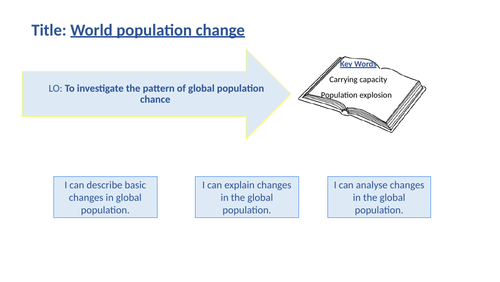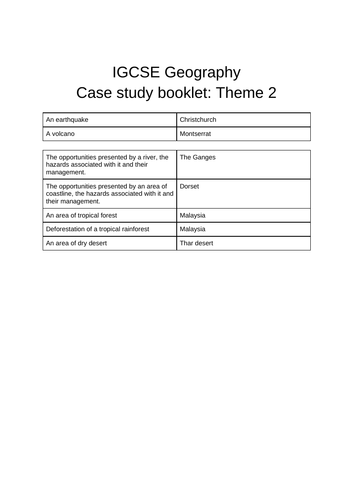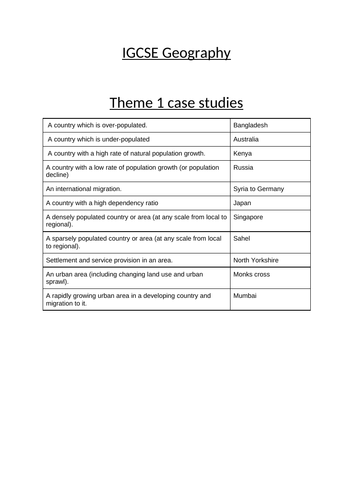36Uploads
3k+Views
1k+Downloads
All resources

CIE GCSE Geography Theme 1 - entire unit of work (lessons and resources)
Full set of high quality resources - powerpoints, print outs, exam questions, skills questions (OS Maps). Ready to pick up and teach - no extra planning needed.
Covers:
Reasons for the rapid increase in the world’s population.
Causes and consequences of over-population and under-population.
Understand the main causes of a change in population size.
A country which is overpopulated and a country which is under-populated.
Reasons for contrasting rates of natural population change
Case study of a country with high rate of natural population growth and a country with a low rate of population growth (or decline).
Population policies (one child policy)
Population structure and population pyramids
Migration
A case study of international migration
settlement patterns
site and situation
settlement hierarchy
Population threshold /sphere of influence
Problems in urban areas
Urban Sprawl
Regeneration
Causes and impacts of urbanisation (push and pull)
Case studies: settlement hierarchy (Manchester), problems in urban areas (Manchester), Urbanisation (Rio)

CIE GCSE Geography Theme 2: the natural environment. Entire SOW - Power points and resources
Full set of high quality resources - power points, print outs, exam questions, all case studies. Ready to pick up and teach - no extra planning needed.
Covers:
Earthquakes
Volcanoes
Earthquakes
Rivers
Coasts
Weather
Climate

ESS IBDP 8.4: Carrying Capacity unit of work
Carrying capacity is the maximum number of a species, or “load” that can be sustainably supported by a given area.
It is possible to estimate the carrying capacity of an environment for a given species; however, this is problematic in the case of human populations for a number of reasons.
An EF is the area of land and water required to support a defined human population at a given standard of living. The measure of an EF takes into account the area required to provide all the resources needed by the population, and the assimilation of all wastes.
EF is a model used to estimate the demands that human populations place on the environment.
EFs may vary significantly by country and by individual and include aspects such as lifestyle choices (EVS), productivity of food production systems, land use and industry. If the EF of a human population is greater than the land area available to it, this indicates that the population is unsustainable and exceeds the carrying capacity of that area.
Degradation of the environment, together with the consumption of finite resources, is expected to limit human population growth.
If human populations do not live sustainably, they will exceed carrying capacity and risk collapse.

ESS IBDP Unit 2 Guided revision/workbook
A set of guided revision booklets, or a set of workbooks to use in class covering all of Environmental Systems and Societies Unit 2. 47 pages total.
Includes RAG grids, diagrams,key terms, questions and instructions on note taking.
2.1: species and populations
2.2 Communities and ecosystems
2.3 Flows of energy and matter
2.4 Biomes, zonation succession
2.4 Investigating ecosystems

ESS IBDP 2.1 Ecosystems and ecology (power point and workbook)
Complete set of resources for environmental systems and societies unit 2.1; power point and workbook.
Ready to pick up and teach no planning needed.
Includes: Ecosystem key terms
Population dynamics and limiting factors (J and S curves)
Interactions: Predation, herbivory, parasitism, mutualism, disease and competition

Geography top trump cards
Printable country top trump cards - great for a reward in class, or for fast finishers!
32 countries, the cards include the population, area, GDP, life expectancy, and HDI.
Print double sided for professional looking top trumps card your students will love!
You can print as many sets as you need!

CIE GCSE Geography - 7 mark questions organised by theme
What it says on the tin - a list of all the past 7 mark questions which have come up on cambridge GCSE Geography paper 1, organised by theme.
A great planning and revision resource.

ESS (IBDP) 1.1 environmental value systems unit of work
Full lessons for IB ESS topic 1: ready to pick up and teach - no extra planning needed.
Covers:
• Signifcant historical infuences on the development of the environmental
movement have come from literature, the media, major environmental
disasters, international agreements and technological developments.
• An EVS is a worldview or paradigm that shapes the way an individual, or
group of people, perceives and evaluates environmental issues, infuenced by
cultural, religious, economic and sociopolitical contexts.
• An EVS might be considered as a system in the sense that it may be
infuenced by education, experience, culture and media (inputs), and involves
a set of interrelated premises, values and arguments that can generate
consistent decisions and evaluations (outputs).
• There is a spectrum of EVSs, from ecocentric through anthropocentric to
technocentric value systems.

GCSE Geography theme 2 case study booklet
Every case study for Cambridge GCSE Geography Theme 2, including all information needed to answer 7 mark questions.
An earthquake
A volcano
The opportunities presented by a river, the hazards associated with it and their management.
The opportunities presented by an area of coastline, the hazards associated with
An area of tropical forest
Deforestation of a tropical rainforest
An area of dry desert

1.1 Population dynamics (Part 1 of CIE Theme 1)
Includes lessons, activties and exam practice questions for:
Describe and give reasons for the rapid increase in the world’s population.
Understand the causes and consequences of over-population and under-population.
Understand the main causes of a change in population size.
Know a country which is overpopulated and a country which is under-populated.
Give reasons for contrasting rates of natural population change
Know a case study of a country with high rate of natural population growth and a country with a low rate of population growth (or decline).
Full set of resources ready to pick and up and teach

KS3 Map skills full unit
This is a full unit of work, including any hand outs, for a year 7 or 8 unit of work on map skills. It covers one half term. It is based on the IB middle years programme framework, but it is suitable for any classroom. Includes assessments and marking rubrics.
Topics
compass directions
coordinates
scale (model building project)
relief
map symbols
fieldwork - conducting a school survey
critical thinking: can we trust maps?
Assessment: design a fictional map, with optional literacy link

CIE IGCSE Geography theme 1 case study booklet
This booklet includes all of the case studies needed for CIE GSCE Geography theme 1. Includes all information needed to answer every 7 mark question.
A country which is over-populated.
A country which is under-populated
A country with a high rate of natural population growth.
A country with a low rate of population growth (or population decline)
An international migration.
A country with a high dependency ratio
A densely populated country or area (at any scale from local to regional).
A sparsely populated country or area (at any scale from local to regional).
Settlement and service provision in an area.
An urban area (including changing land use and urban sprawl).
A rapidly growing urban area in a developing country and migration to it.

GCSE Geography Rivers full lessons
All lessons and resources to teach Cambridge International GCSE Rivers. No extra planning needed.
Includes:
key terms
hydrological cycle
Erosion
Transportation
Deposition
Upper, middle and lower course landforms
Causes of flooding
Flood management
River case study - hazards, opportunities and management

1.5, 1,6, 1.7 Theme 1 CIE GCSE Geography full lessons (Settlement, urban settlements, urbanisation)
Full set of high quality resources - powerpoints, print outs, exam questions, skills questions (OS Maps)
Covers:
-settlement patterns
site and situation
settlement heirarchy
Population threshhold/sphere of influence
Problems in urban areas
Urban Sprawl
Regeneration
Causes and impacts of urbanisation (push and pull)
Case studies: settlement heirarchy (manchester), problems in urban areas (manchester), urbanisation (Rio)

GCSE rivers knowledge organiser
Two sided A3 knowledge organiser, partially completed for revision. Includes detailed diagrams. Complete GCSE rivers unit - CIE but suitable for AQA and edexcel.

3 Lesson Geography project for KS3: design a virtual fieldtrip
This is a three lesson project perfect for year 6, 7, 8 or 9 Geography. It includes a powerpoint with all of the needed instructions for each lesson, and a planning document for students to use.
















